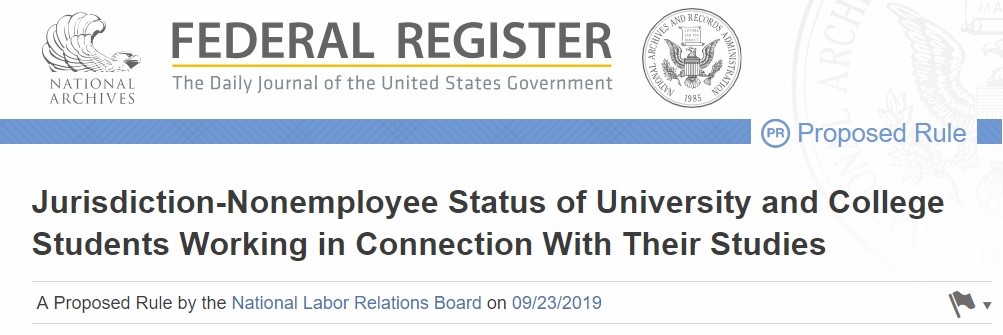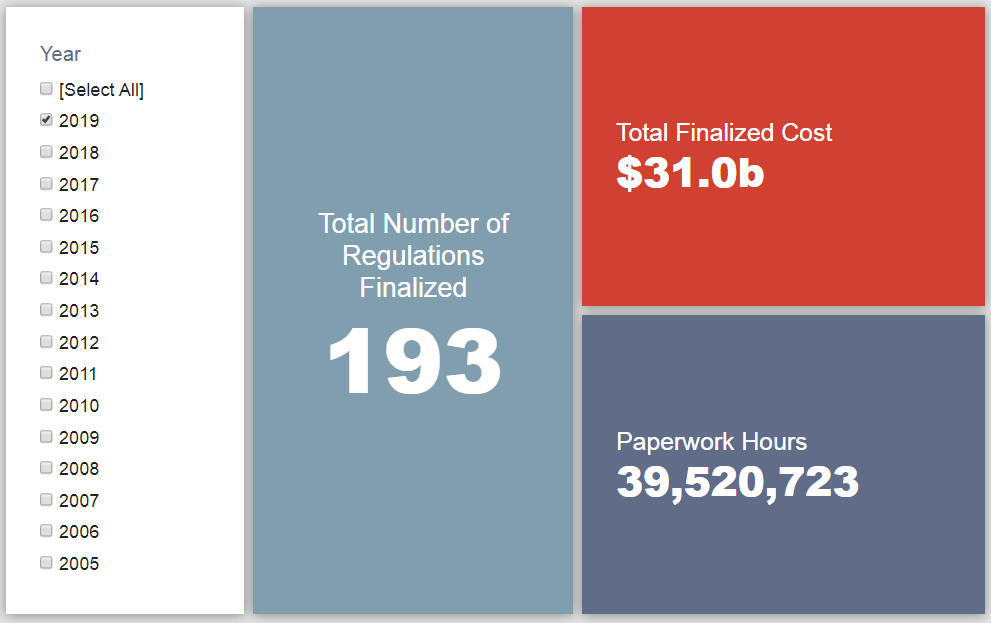Week in Regulation
September 30, 2019
Labor Rulemakings Rule the Week
As fiscal year (FY) 2019 comes to a close, the past week provided a real shot in the arm to the deregulatory side of the regulatory budget. The Department of Labor (DOL) led the way in this regard, primarily behind its updated Overtime Rule. The National Labor Relations Board (NLRB) also got in on the action as it weighed in on the employment status of graduate students. Across all proposed and final rules, agencies published $7.7 billion in total net cost savings but added 2.6 million hours of annual paperwork.
REGULATORY TOPLINES
- New Proposed Rules: 47
- New Final Rules: 73
- 2019 Total Pages: 51,272
- 2019 Final Rule Costs: $31 Billion
- 2019 Proposed Rule Costs: -$836.7 Million
TRACKING THE REGULATORY BUDGET
The most significant rulemaking affecting the regulatory budget under Executive Order (EO) 13,771 was DOL’s new Overtime Rule. The American Action Forum’s Isabel Soto breaks down the specifics of the rule here. While the rule expands the pool of affected workers (and thus the costs) from the currently enforced level (“2004 Rule”), for the purposes of regulatory budgeting, DOL estimates that this change would yield roughly $535 million in annualized savings, or roughly $7.6 billion in present value.
The rule presents an interesting case of baseline-setting in regulatory measurement. The agency arrives at that figure by using the costs of the Obama Administration’s version of the rule as the baseline. While that rule never fully went into effect, it was technically on the books. As such, DOL notes that for EO 13,771 purposes, “the economic impacts should be compared to what is currently published in the [Code of Federal Regulations] CFR.” Thus, it produces net savings.
In terms of paperwork, however, the parameters for calculating paperwork burden changes under the Paperwork Reduction Act (PRA) consider this a burden-increasing action. The baseline under that metric is the paperwork required under 2004 Rule. Since this expands the pool of affected employees and employers, it necessarily expands the aggregate burden – by about 2.6 million hours.
So far in FY 2019 (which began on October 1, 2018), there have been 67 deregulatory actions (per the rubric created by EO 13,771 and the administration’s subsequent guidance document) against 35 rules that increase costs and fall under the EO’s reach. Combined, these actions yield quantified total net costs of roughly $3.7 billion. This total, however, includes the caveat regarding the baseline in the Department of Agriculture’s “National Bioengineered Food Disclosure Standard.” If one considers that rule to be deregulatory, the administration-wide net total is approximately $3 billion in net cost savings. The administration’s cumulative savings goal for FY 2019 is approximately $18 billion. The fiscal year ends today.
THIS WEEK’S REGULATORY PICTURE
This week, the NLRB aims to establish a durable policy about students working in connection to their studies at colleges and universities.
The NLRB published a proposed rule in the September 23 edition of the Federal Register that would address the long-standing question of whether graduate student assistants and undergraduate research assistants – more broadly, students who perform work connected to their studies – at private colleges and universities are “employees” under the National Labor Relations Act (NLRA). If considered employees, these students would have organizing rights typical of more traditional workers. The NLRB is proposing a rule that would assert that such students are not employees under the NLRA.
What is notable is that this is the first time the NLRB has sought to determine in its regulations the status of such students. Previously, the definition was dependent on precedent in cases before the NLRB. These precedents are less enduring than regulatory code, exemplified by the fact that since 2000 three different precedents have emerged. Prior to 2000, the NLRB held that such students were not employees. In 2000, the Board ruled that some graduate student assistants are considered employees. That decision was reversed in 2004. In 2016, the NLRB not only reversed the 2004 reversal, but extended coverage to undergraduate student research assistants.
Citing this flip-flopping and the uncertainty it creates, the NLRB is proposing to codify in its regulations that such students are not employees. Overturning this proposed rule, assuming it is eventually finalized, will be possible – but not without the NLRB going through the rulemaking process and establishing a factual record that supports changing the regulatory text.
TOTAL BURDENS
Since January 1, the federal government has published $30.1 billion in total net costs (with $31 billion in finalized costs) and 44.6 million hours of net annual paperwork burden increases (with 39.5 million coming from final rules). Click here for the latest Reg Rodeo findings.













